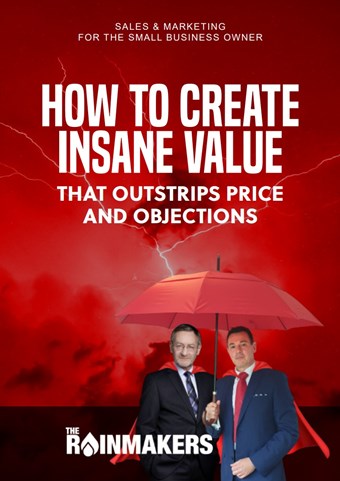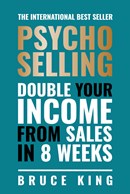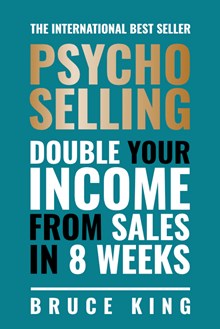DOUBLE YOUR INCOME IN JUST 8 WEEKS
Download this all-time classic bestselling book from Bruce King free.
How to write copy that persuades people

By Chris Haycock | 30 June 2021
Struggling to get your readers to read your copy? Use these techniques to ensure that you grab their attention - right the way to the end.
Are you able to persuade your customers to buy from you?
Can you inspire and motivate a potential customer to go reaching for their wallet - just from injecting persuasion into your words?
Persuasion is the backbone of powerful, effective copywriting, and if you’re not being persuasive with your words, then you’re missing the point of marketing.
Persuasion is EVERYTHING.
We're not talking about manipulation here. There are loads of manipulation tricks that you can use, but they’re not really ethical. We're talking persuasion - and the methods you can use to entice new customers.
We use persuasion in all aspects of our lives - when we’re talking to our children to get them to put their shoes on. When we’re having a disagreement with our wives - or even getting a good deal from the fruit and veg man at the market.
Whenever we communicate with anyone else in life, we use subtle persuasive techniques all the time - most of the time we’re completely unaware that we’re doing it.
If you feel bad for using persuasion in your marketing, then there’s no real reason to be in business. You must be able to persuade people to become your customers.
Most of the time, marketing revolves around the use of words to convey a powerful message that convinces people to buy. Copywriting accounts for a huge amount of your sales. So, it makes sense that your copywriting should be as persuasive as possible.
The more persuasive your words are, the more sales you make. Don’t feel guilty or embarrassed about this - especially when your competitors are doing the same - and winning more customers than you.
So, diving right in, let’s look at some persuasion techniques that YOU can use to increase your sales.
The Second-Person Pronoun
First up, let’s talk about the word “youâ€, and how it can transform your marketing copy.
In English, “you†is a second-person pronoun, and you MUST use it in your marketing copy. As opposed to “we†- a first-person pronoun, the word “you†is far more powerful than you might first think.
When it comes to marketing copy, consumers are much more responsive when that copy addresses their needs and concerns, rather than about you and your business.
In reality, your customers will be taking a me, me, me approach, and care very little when you write about you.
Let me emphasise this again. Your customers don’t particularly care about you or your business. They care about solving their problems. So why make your copy all about you and your business?
Whenever you're writing, always switch the focus away from you by removing most - if not all - of the times where you mention I, we, us etc. and use the second-person pronoun, such as “youâ€, “you’reâ€, and “yoursâ€.
This technique works extremely well, because you are telling the reader that you’re thinking of THEIR needs, not yours.
By understanding your clients needs, you're able to write persuasive, powerful words and sentences that use the words “youâ€, “you're†and “your’sâ€. So, you’re changing your emphasis from you and your products - to your customer’s and their needs.
These pronouns will also help turn your marketing copy into a conversation in your reader’s minds. For example,
You're amazing, but imagine how truly incredible you could become if you discovered the secret ingredient that will improve your life forever.
See how it uses the word “You’reâ€, and provokes emotion to conjure up thoughts, stories and dreams in their heads?
Yes, I know it sounds cheesy, but injecting your copy with the word “you†is one of the most powerful things you can do to transforming the words and sentences you write for your business.
Benefits before features
Imagine that you've broken your bed (I won't ask why!), and you need a new one. You don't want to buy a new bed. You want to buy a good night's sleep, right? Go into a bed retailer and you'll get promises of comfortable, uninterrupted sleep.
Sure, you can find out the key features, such as the materials used, the maximum weights, sizes and so forth, but you're sold benefits, rather than features, such as COMFORT. The fact that it's made of polyurethane foam is secondary, isn't it?
By focusing on the benefits BEFORE the features, you're addressing the needs of your customers. That's ultimately what's going to make them buy from you.
You can follow it up by listing the features afterwards, of course. But grabbing their attention quickly by telling the reader you understand their needs, will help you sell more.
So, always think about your customer's primary reason for being on your website, ie “what's in it for me?†- and answer that question by listing the benefits.
Avoid jargon and buzzwords
When writing content for your website, it's tempting to show off your linguistic skills - or your excellent grasp of English - by using complex jargon, buzzwords, and fluff that no one really understands in an attempt to impress your readers.
However, it actually has the opposite effect. Consumers are put off by industry jargon, fancy words, or sentences that are too full of 'fluff'. Remember to take into account the range of people who will be using your website, and write for the lowest common denominator.
In other words, don't try to bamboozle people with buzzwords or language that your audience won't understand. Stay on their level, and communicate in a way that they're familiar with.
Likewise if you think it’s clever to make your words cryptic. Unless they’re on the GCHQ recruitment website, all you’ll do is alienate people.
If in doubt, show your words to a 15-year-old. If they don’t understand it, start again from scratch and redo it until they do understand it.
Persuasive 'power words'
Ever wondered why professional copywriters are able to turn boring words into powerful statements? That’s because they're able to use powerful language that evokes an emotion, stimulates interest, creates a desire and provokes a response, I.e. an action.
Language has the power to do all that.
Top copywriters craft words in such a way as to persuade their readers to take action.
The English language is jam-packed with powerful words that can sprinkle magic dust into your marketing copy. After all, why use boring, every-day words and phrases when you can transform sentences into explosive statements that grab the reader’s attention?
Here are some of the English language's most powerful words in advertising:
New, save, safe (or safety), proven, love, discover, guarantee, health, results, and you - arguably the most powerful word in the English language.
No one wants to read boring copy, so inject your sentences with power words, and you make them more persuasive.
The AIDA principle
There is a powerful - and incredibly persuasive - copywriting principle that has been used for decades by most of the top copywriters in the world.
It’s called The AIDA Principle, which stands for Attention, Interest, Desire, Action. Let’s take a quick look at how you can put it into practice in your marketing copy.
Attention… which means you need to grab the reader’s attention. If you don’t catch the eye of the reader, then they’re not going to notice you at all, so use images, graphics and illustrations that scream, “LOOK AT THISâ€.
Interest… remember we talked about selling the benefits before the features? Maintaining the reader’s interest is crucial throughout your copy if you want to convert them into a buyer.
Desire… it’s your job to persuade the reader that they really need this product, so sizzle the deal by creating an offer that’s completely irresistible.
Action… once you’ve done the job of getting the reader to salivate over your product, you then need to get them to take action - by explaining EXACTLY what they need to do next to secure your amazing deal.
Eureka! I guarantee you'll sell more and capture more leads by following the AIDA principle. If you want to find out more, check out the other tutorial on The Rainmakers, which goes deeper into the AIDA Principle.
Tone of voice
The tone of voice you adopt in your marketing copy will obviously depend on its subject matter - as well as the business itself.
For example, solicitors would need to adopt a serious, professional tone of voice, whereas a builder may want to use a more friendly and relaxed tone.
Decide early on how you want your visitors to “hear youâ€, and be consistent with it across all your marketing.
Whichever tone of voice you decide to use, try to make it as 'conversational' as you can. No one wants to read lifeless, mundane corporate copy. They want to hear the human language, not something that sounds like a press release from the Head Office at Ofcom.
The best way of finding your conversational tone of voice is to imagine that you're discussing your product in person. Write how you speak, and this will be reflected in your words.
For me, when I'm typing away, I imagine that I'm sitting in a pub explaining something to a friend. This works really well for me - until I imagine myself getting tipsy!
Compelling headlines and titles
A good title can increase the engagement of a web page by a huge amount.
Titles and headlines are there to grab your visitor's interest and draw them into your page further. Once they're drawn into the page, it's up to how you write the content to keep them interested and to draw them towards your sales funnel.
Headlines and titles are there as a way of giving your readers a small glimpse of what's to come on your page, so you need to spend time to ensure that they're effective.
However, don't attempt to mislead your users with sensation and hyperbole. These techniques will leave your readers shaking their heads in dismay, because they can see right through it. Leave that for the clickbait type of writing.
The idea is to review your page, and compress the most important bits into a short but meaningful title. Read it back to yourself. Ask yourself, “is this interesting?†If not, continue to work on it, and test different variations with a split test, if you can.
Keep titles short, to-the-point but compelling, and use “interesting†words which are front-loaded (at the beginning) of the title - to pique the reader's interest.
Use numbers wherever you can (for example, “11 Ways You Can Skin a Catâ€), because they are describing to the reader exactly what they're going to be getting. It's specific. Readers love to know what they're getting before they start reading - and they love lists!
And… as I mentioned earlier, try to use the word “you†somewhere in the title.
Avoid typos and grammatical mistakes
Yeah, that old chestnut again. If you don't take the time to make sure your products and brand isn't portrayed professionally, then your visitors will lose trust in your business.
A while ago, there was an entrepreneur called Charles Duncombe, and he discovered that a single spelling mistake cut his sales by a half. He was running a website selling tights with a glaring spelling mistake that no one in the marketing team spotted - but their customers did.
After they corrected it, he was surprised to discover that sales doubled. Enough said!
I like to think that most people will turn a blind eye to the odd typo or grammatical mistake. But there are plenty more that are influenced negatively by typos. You really don’t want to lose sales just because of typos.
If you've written your web content yourself and are unsure of your English skills, then get someone else to read it for you and report any errors they may find. They might just help you avoid lost sales.
Provide incentives
Almost always, people need an incentive to buy. That’s especially true for people who might be sitting on the fence, deciding whether to buy or not.
They’ve got a shortlist of 3 or 4 different businesses that they’re ready to buy from, and are deciding which one to choose.
So, it makes sense to provide time-limited special offers to those who just need a little push with an incentive.
Another technique you can add here is to make your offer time-sensitive, which will drive a sense of urgency.
This 'fear of loss' technique is a persuasive method designed to get people to act now - and quickly before the offer is gone.
For example: We've only got 5 of these widgets left in stock, and we don't know when we're going to be making more. Grab a couple now to avoid missing out.
Sometimes a little incentive - and a bit of urgency - is all it takes to convince them to go for it.
---
So, there are a whopping NINE ways that will help you to create marketing copy that’s infinitely more powerful, persuasive and compelling to your readers.
---

There's more inside The Rainmakers Club
Ready to double, triple or even quadruple your sales? Join the Rainmakers Club today and get access to hundreds more worksheets, ebooks, tutorials, guides, tools and downloads.
NEW FOR 2022! Join our growing club of successful small business owners and get The Raindeck free: a 3-deck strategy for brainstorming and running successful marketing campaigns.

HOW TO CREATE INSANE VALUE
A must-have read for anyone that sells anything
Discover techniques and methods that will increase your product's perceived value - without having to change your product or prices.
Get the book freeGET STARTED WITH
The Rainmakers
Join today for the price of your daily cup of Mocha coffee, and become a sales and marketing giant.
Learn sales & marketing
Double, triple, or quadruple your sales and income.
Expert mentoring
Learn from renowned sales and marketing experts.
Exclusive resource library
Tools, downloads, cheat sheets and worksheets to help you succeed.
Free Raindeck strategy box
Brainstorm, plan and execute brilliant marketing campaigns in no time.

















